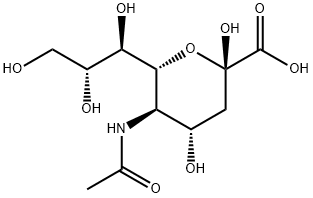Description
Sialic acid is a generic term for the N- or O-substituted derivatives of neuraminic acid, a monosaccharide with a nine-carbon backbone.It is also the name for the most common member of this group, N- acetylneuraminic acid ( Neu 5Ac or NANA). Sialic acids are found widely distributed in animal tissues and to a lesser extent in other species, ranging from plants and fungi to yeasts and bacteria, mostly in glycoproteins and gangliosides. The amino group generally bears either an acetyl or glycolyl group, but other modifications have been described. The hydroxyl substituents may vary considerably; acetyl, lactyl, methyl, sulfate, and phosphate groups have been found. The term "sialic acid" (from the Greek for saliva, σ?αλον/sialon) was first introduced by Swedish biochemist Gunnar Blix in 1952.
Chemical Properties
N-acetylneuraminic acid is an N-acyl derivative of neuraminic or acid amino sugar derivative, derived from N-acetylmannosamine and pyruvic acid. It is an important constituent of glycoproteins and glycolipids. N-acetylneuraminic acid occurs in many polysaccharides, glycoproteins, and glycolipids in animals and bacteria.
Physical properties
The numbering of the sialic acid structure begins at the carboxylate carbon and continues around the chain. The configuration which places the carboxylate in the axial position is the alpha-anomer.
The alpha-anomer is the form that is found when sialic acid is bound to glycans, however, in solution it is mainly (over 90 %) in the beta-anomeric form. A bacterial enzyme with sialic acid mutarotase activity, NanM, has been discovered which is able to rapidly equilibrate solutions of sialic acid to the resting equilibrium position of around 90 % beta 10 % alpha.
Uses
Carbon 13 labelled analogue of N-Acetylneuraminic acid (A187000).
Definition
ChEBI: N-acetylneuraminic acid is an N-acylneuraminic acid where the N-acyl group is specified as acetyl. It has a role as an antioxidant, an EC 3.2.1.18 (exo-alpha-sialidase) inhibitor, a bacterial metabolite, a human metabolite and a mouse metabolite. It is a conjugate acid of a N-acetylneuraminate.
Biosynthesis
In bacterial systems, sialic acids are biosynthesized by an aldolase enzyme. The enzyme uses a mannose derivative as a substrate, inserting three carbons from pyruvate into the resulting sialic acid structure. These enzymes can be used for chemoenzymatic synthesis of sialic acid derivatives.
Biological Functions
Sialic acid-rich glycoproteins (sialoglycoproteins) bind selectin in humans and other organisms. Metastatic cancer cells often express a high density of sialic acid-rich glycoproteins. This overexpression of sialic acid on surfaces creates a negative charge on cell membranes. This creates repulsion between cells (cell opposition) and helps these late-stage cancer cells enter the blood stream.
Sialic acid also plays an important role in human influenza infections.
Many bacteria also use sialic acid in their biology, although this is usually limited to bacteria that live in association with higher animals (deuterostomes). Many of these incorporate sialic acid into cell surface features like their lipopolysaccharide and capsule, which helps them evade the innate immune response of the host.[6] Other bacteria simply use sialic acid as a good nutrient source, as it contains both carbon and nitrogen and can be converted to fructose-6- phosphate, which can then enter central metabolism.
Sialic acid-rich oligo saccharides on the glyco conjugates ( glyco lipids, glyco proteins, proteoglycans) found on surface membranes help keep water at the surface of cells . The sialic acid - rich regions contribute to creating a negative charge on the cells' surfaces. Since water is a polar molecule with partial positive charges on both hydrogen atoms, it is attracted to cell surfaces and membranes. This also contributes to cellular fluid uptake.
Sialic acid can "hide" mannose antigens on the surface of host cells or bacteria from mannose - binding lectin . This prevents activation of complement.
Sialic acid in the form of poly sialic acid is an unusual posttranslational modification that occurs on the neural cell adhesion molecules (NCAMs). In the synapse, the strong negative charge of the polysialic acid prevents NCAM cross-linking of cells.
Biochem/physiol Actions
Both sialic acid and neuraminic acid are loosely used to refer to conjugates of neuraminic acid. N-Acetylneuraminic acid is often found as the terminal sugar of cell surface glycoproteins. Cell surface glycoproteins have important roles in cell recognition and interaction as well as in cell adhesion. Membrane glycoproteins are also important in tumor growth and metastases.
in vitro
N-Acetylneuraminic acid (0 - 2 mg/mL, 2 days) has no effect on cell proliferation but significantly decreases the tyrosinase protein level, the number of melanosomes, and the p62 protein level and increases the CCT3, CCT5, and LC3-II protein levels and mRNA levels in B16 melanoma cells.
N-Acetylneuraminic acid (0 - 500 μM, 12 h) specifically binds to RhoA and Cdc42 and activates cardiomyocytes' Rho/ROCK-JNK/ERK signaling.
in vivo
N-Acetylneuraminic acid (0 - 20 mg/kg, i.p., twice a day for 6 weeks) triggers myocardial injury in healthy rats.
